 |
|
|
|

|

|
Five Intel chips that changed the world |
|
|
|
|
Five little silicon chips. Count them: Five. And the world would never be the same. |
|
|
|
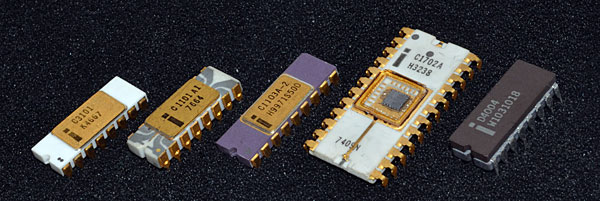 |
|
|
|
The name of Intel, the company where I spent
26 fascinating year of my career, is a household word (which is
actually strange, when you consider that it’s a manufacturer of
electronic components that go inside computers; I mean, how many
people can name the maker of the spark plugs in their car?) Indeed,
Intel’s combination of innovative product development, manufacturing
strength and superb marketing has made it the most famous chip
manufacturer in the world. Everyone has heard of Intel Inside, and
can name microprocessors like the Intel Core, the Centrino and the
Pentium; old timers may also remember the 386 and 486 processors. And yet, Intel’s most important innovations far precede those processors. They were embodied in five chips that all came into existence during the company’s first four years, when it was a struggling start-up in what would come to be known as Silicon Valley. These chips -- all of which are represented in my collection -- are all historical “Firsts”, the first commercial instances of their kind, and they include all the building blocks required for making a computer. With these innovative chips Intel enabled the Personal Computer revolution that would later change our world beyond recognition, and shower riches not only on Intel, but also on Apple, Microsoft, and countless other companies. Those were four magical years; and these five modest, largely unremembered chips are their miraculous result. Here they are: |
|
|
|
||
|
April 1969. Intel 3101: The first solid state memory chip. Intel’s first product, this is a 64-bit SRAM (Static Random Access Memory). It applied the newly developed Schottky Bipolar technology, which made it twice as fast as earlier implementations. |
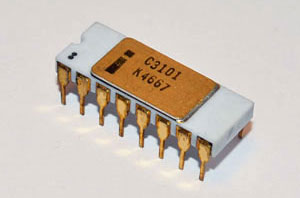 |
||
|
|
|
July 1969. Intel 1101: The first MOS memory chip. A 256-bit SRAM (Static Random Access Memory). The 1101 was developed in parallel with the 3101, but lost the race to be Intel’s first product. It was produced with Silicon gate MOS (Metal Oxide Semiconductor) technology, which gave Intel the edge it needed to produce high density memories. |
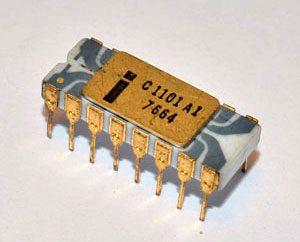 |
|
|
|
October 1970. Intel 1103: The first DRAM memory chip. A 1024-bit DRAM (Dynamic Random Access Memory). This is the chip that kicked magnetic Core Memory out of the game, making Intel a world leader in memories for a decade. |
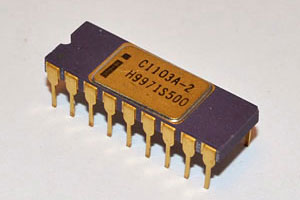 |
|
|
|
September 1971. Intel 1702: The first EPROM chip. A 2048-bit EPROM (Erasable Programmable Read Only Memory). This chip, which can be erased by shining UV light through its quartz window, was based on a serendipitous discovery made by Dov Frohman. |
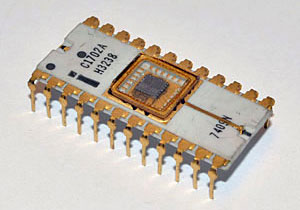 |
|
|
|
November 1971. Intel 4004: The first microprocessor. A 4-bit microprocessor (central processing unit on a chip). The 4004 had only 2300 transistors and ran at a clock speed of 740KHz; but it was a historic breakthrough that enabled the ubiquitous computing technology we have today. |
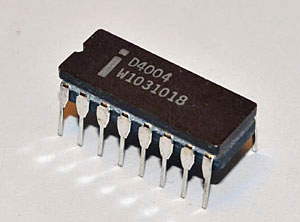 |
|
|
|
In case you wonder, Random Access Memory is
where all the programs and data are stored during computation, while
EPROM -- since superseded by Flash memory -- held firmware like the
BIOS code. Bipolar and MOS are two technologies used to produce
chips, and it was the switch to MOS, driven by Intel, that enabled
the large scale integration necessary for the processors and memory
chips of the PC revolution. Between them, these five chips embody
all the major functions needed to build a personal computer. By the way, widely used statements like “The first such-and-such chip” need to be qualified. The 1960’s saw a lot of laboratory experimentation with new chip technology, and knowledge and people moved around the young industry. Thus, the 3101 was not the very first time someone implemented memory in Silicon; rather, it was the first commercial, practical, viable implementation of such a memory device. Intel’s strength was in integrating existing know-how from other companies (notably Fairchild, from where Intel’s founders all came), its own design innovations, manufacturing breakthroughs and sheer can-do audacity to bring to market denser, cheaper, faster chips in a reliable fashion. It still does that today. The one exception is the EPROM, which was truly a new, unexpected discovery with no precedent in other companies. Lastly, a bonus “First”: |
|
|
|
||
|
August 1972. Intel 8008: The first 8-bit microprocessor. An 8-bit microprocessor (central processing unit on a chip). Once it got on a roll, Intel went from 4 bits to 8, and later on to 16, 32, and finally the 64-bit processors commonly used in today’s personal computers. |
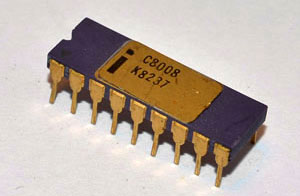 |
||
|
|
|
Incidentally, when Intel did all that, it had less than 200 employees. I had the privilege of working with some of them when I joined the company ten years later. Those were the days! |
|
|
|
Exhibit provenance: eBay, acquired over the years from different sellers. More info: |
|
|
|
|
|
|
|
Home | HOC | Fractals | Miscellany | About | Contact Copyright © 2014 N. Zeldes. All rights reserved. |
|